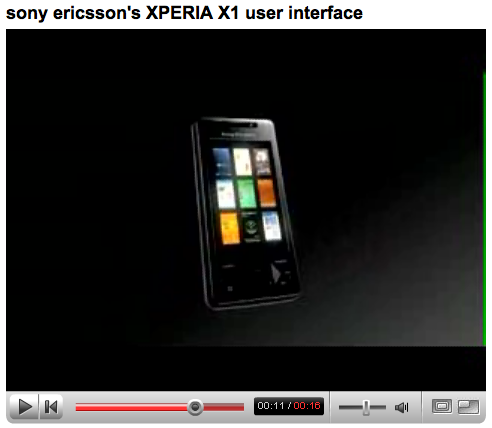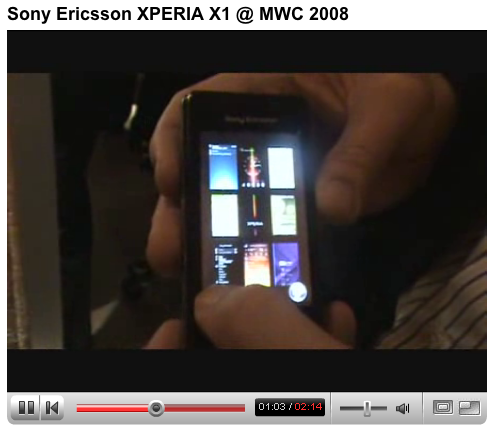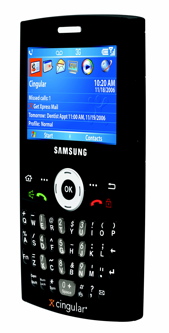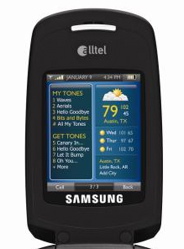 BREW 2008, SAN DIEGO - Adobe and Qualcomm announced Flash would be fully integrated into the BREW Mobile Platform. The news was the latest in a string of great announcements about the platform that are taking the BREW and the Flash Lite communities by surprise. Last week’s announcement came on the heels of some great developments on the Flash front with Sony Ericsson announcing all its future handsets will be Flash enabled and with Adobe’s announcement that licensing the Flash player will be free (meaning other handset makers are likely to follow).
BREW 2008, SAN DIEGO - Adobe and Qualcomm announced Flash would be fully integrated into the BREW Mobile Platform. The news was the latest in a string of great announcements about the platform that are taking the BREW and the Flash Lite communities by surprise. Last week’s announcement came on the heels of some great developments on the Flash front with Sony Ericsson announcing all its future handsets will be Flash enabled and with Adobe’s announcement that licensing the Flash player will be free (meaning other handset makers are likely to follow).
Qualcomm and Adobe are partnering to create, or rather revamp, Qualcomm’s BREW Mobile Platform. For an Adobe perspective Read Bill Perry’s overview on his FlashDevices blog. Technically, BREW already was a mobile platform to begin with, but in the wake of the iPhone and possible Android disruptions, it’s not surprising this has been in the works. These companies are looking for partners to create platforms and alliances to ensure their competitive edge. Could this mean that we will see AIR mobile (Adobe Integrated Runtime) soon? And if so, will it cooperate with this new BREW Mobile Platform?
The Adobe Flash Lite player has been available as a BREW application (BREW engineers call it an extension) for almost 2 years — but in its current state, it allows Flash Lite applications to run only as siloed downloads (for games, screen savers, visual ringtones, etc.). There was no good way to use Flash Lite for anything other than tiny apps, unless you had the full support of Adobe in helping you write a custom player for your platform of choice. In addition, it was clear Adobe did not have plans to port Flash Lite 3 to the BREW platform as a BREW app.
Fast forward to now… Continue Reading »
Add this to digg, del.icio.us, etc.
HTC has released a promotional video of the new HTC Touch Diamond user interface. The device boasts touch input and an accelerometer with HTC’s TouchFlo 3D rendering. The Windows Mobile 6 device will hit shelves any week now in the UK. The product is slated for the US later this year.
Add this to digg, del.icio.us, etc.
At last years’ JavaOne conference Sun Microsystems announced its entry into the presentation layer technology race. JavaFX Mobile will compete with Qualcomm’s uiOne, Adobe’s Flash Lite and Microsoft’s SilverLight.
From the AndroidGuys blog “…Earlier this week, Sun announced details for the forthcoming JavaFX Mobile and even demonstrated it with an Android prototype. Targeting multimedia phones, it will be part of a few planned JavaFX stacks due from the company. Typically, most phones running Java rely on the language for user-installed applications. For JavaFX Mobile however, it will have Java running behind everything from the user interface (UI) toolkit to the telephony, media, and browser software. Ideally, you’ll have the same experience with desktops, mobile devices, set-top boxes, and even automobile dashboards.”
Add this to digg, del.icio.us, etc.
I’m discovering more and more that it’s not the user experience groups within the carriers and handset manufacturers that we need to convince about a new interface innovation; it’s the chipset manufacturers. While the vision and promise of a given UI might grease the necessary wheels of approvals to get an innovation to market, it rarely arrives without a degree of compromise.

Take the Sony XPERIA X1. In this highly-polished pitch video, the UI shucks and jives with all the agility of motion graphics at their finest. And sure, it works. For a UI that relies on a simple 3-view switcher to differentiate, it does make for a unique mobile experience. It certainly is more interesting than a lot of phone UIs out there. However, the actual device experience does lack in the speed department. The experience becomes even more painful when navigating the arched carousel, as demonstrated in this video.

Are companies hoping simple-minded consumers won’t notice these details? Unfortunately, in this example, an interesting UI transition has now become something that many users can’t help but notice — and wait for — every time they switch modes. Despite the fact that this is largely driven by the processor’s ability to push the objects around screen, this is the very stuff that perpetuates the stereotype that visual designers are all about gratuitous graphics at the cost of UI efficiency.
Sony XPERIA, marketing video:
http://www.youtube.com/watch?v=Ay7RMHcUuGQ
Sony XPERIA, hands-on at 3GSM:
http://www.youtube.com/watch?v=wuo9CAZCbIE
http://www.youtube.com/watch?v=4wU5eiMR57s
Add this to digg, del.icio.us, etc.
Symbian seems to be in the first stage of grief over Android, Google’s new operating system for mobile. From an article by the BBC: “Google’s dominance of the web will not translate to the mobile phone market, a senior executive at Symbian has said.”
From the Symbian exec:
“About every three months this year there has been a mobile Linux initiative of some sort launched.
“It’s a bit like the common cold. It keeps coming round and then we go back to business. We don’t participate in these full stop. We make our own platform and we are focused on driving that into the mobile phone market at large ever more aggressively.”
And two paragraphs later:
“Meanwhile, the head of Nokia in the UK said the firm was in discussions with Google about using the platform.”
Read the BBC News article.
Link via Slashdot.
Add this to digg, del.icio.us, etc.
We only notice tectonic plates when enough tension gets released as an earthquake. (Yes, I’m in California, and yes we had a 5.3 the other day.) The trend toward openness and toward user choice is slow going, but we don’t feel it until someone makes a big announcement like Google’s this week.
The shift is happening. Apple’s iPhone launch was a big deal, proving that a device manufacturer can play first fiddle in the US mobile industry (and AT&T isn’t complaining that 40% of iPhone buyers are new subscribers) and more importantly, proving that a device’s user experience can lead every part of the conversation; within the industry and with consumers.
Google’s announcement feels like a corollary to Apple’s. It adds evidence that a non-carrier can wrangle support from across the mobile industry (handset and chip OEMs, carriers, platform developers) to create an open platform.
Google’s announcement has interesting possibilities. What will device manufacturers come up with if they don’t have to pay Microsoft (or anybody else) for their OS? What will the carriers create if they didn’t have to pick from the pros and cons of the various OSs, but if they had the ability to write their own branded UI for a line of devices? What will the third party application developers be able to do with a more open, internet-powered approach (as is starting to happen on the Apple front, but that’s another debate.) What will content providers create for users if Google can prove an ad-subsidized mobile model will work?
Someday we’ll all look back and remember how cute Google was when it was just a little rainbow logo search field staring at you from a blank page.
Add this to digg, del.icio.us, etc.
 Josh Ulm, Director of User Experience, Adobe spoke at the company’s annual MAX conference in Chicago.
Josh Ulm, Director of User Experience, Adobe spoke at the company’s annual MAX conference in Chicago.
I especially liked his before and after review of Yahoo! Go and Google Maps for mobile.
His comments on “Demonstrating the Brand” were right on — especially his point about the newish Yahoo! Go application. The user interface is a huge improvement over the previous Yahoo! WAP version, but even though the visual branding is much better aligned, the application falls short of the Yahoo! brand promise. Yahoo! is built on bringing me my content, and somehow the Yahoo! Go app manages to deliver merely generic content.
This point is one the mobile industry, and more specifically, the mobile user experience community is not focused enough on. Focusing on getting the usability and the interactions right is only part of the equation. Don’t lose sight of the content. Is it right? And is its delivery true to the brand.
Since a majority of Ulm’s thoughts are shared in Mobile Persuasion I’ve just focused on the highlights.
Add this to digg, del.icio.us, etc.
1// Adobe is reporting that Flash Lite will now support video.
2// Wired has posted their interview with John Maeda, who spoke at the TED Conference in Monterey, CA this week. When probed on his favorite manmade designs, he offered this:
“I like stuff designed by dead people. The old designers. They always got it right because they didn’t have to grow up with computers. All of the people that made the spoon and the dishes and the vacuum cleaner didn’t have microprocessors and stuff. You could do a good design back then.
I think if you’re a young designer now, you’ve got the internet and you’ve got screens all over the place — it’s awful hard. Technology is just so powerful now. You can do so much with so little. You can shove it into the size of a quarter. For designers to design great objects where technology is concerned, that’s hard.”
Too true. (Thanks Nancy.)
3// Last weeks’ Game Developers Conference (GDC) in San Francisco, yielded some interesting discussion, like the keynote on networked mobile gaming.
4// File under: alternate desktop metaphors. Check out “BumpTop,” a desktop UI paradigm that uses physical behavior to aid organization of files. Whether or not the desktop metaphor is appropriate to mobile UI, could this type of physics and motion apply to mobile touch screens using a finger tip or thumb as the stylus?
5// Opera Mini. At most it looks like a strike against the operator content foothold. At the least it may be a reason not to have to buy a smartphone. (Thanks Christian.)
Add this to digg, del.icio.us, etc.
Jared Benson will present “Designing the Mobile User Experience” today at 11am, Pacific Time. The free webcast is hosted by Dynamic Graphics. We hope you’ll join us.
UPDATE: The archived presentation is now available for viewing. Requires Real Player or Windows Media Player.
UPDATE 2: A text transcript of the Q&A session has been posted up to the DGUSA website. Enjoy.
Add this to digg, del.icio.us, etc.
The best mobile news and discussions for the week of 19 January, 2007.
Culture of Mobility
1// Mayor Bloomberg announced that New York will soon allow 911 (and 311) to accept digital photos and videos.
“If you see a crime in progress or a dangerous building condition, you’ll be able to transmit images to 911, or online to nyc.gov,�? the mayor said in his annual State of the City address. “And we’ll start extending the same technology to 311 to allow New Yorkers to step forward and document nonemergency quality of life concerns, holding city agencies accountable for correcting them quickly and efficiently.�?
2// Book, I hot mod balk. (a.k.a - Cool, I got one call.)
Kottke.org has a mention of kids in the UK using “book” as a synonym for “cool.” It’s rooted in a T9onym where the word cool and the word book both come up when you enter 2665 on a T9 keypad.
3// In the clamor of the Apple Keynote, Nokia and Visa’s announcement of mobile Visa payments in the US snuck under the radar.
Mobile technology news
4// Mainstream press picks up on Qualcomm: BusinessWeek has a feature on emerging mobile technologies primarily mentioning Qualcomm’s mobile TV offering, MediaFLO.
 5// Mobileburn has a review of Samsung + Cingular’s latest sleek little smartphone — the BlackJack, a Windows Mobile handset that is slightly smaller than Motorola’s popular Q. Being skeptical about Samsung handsets doesn’t mean I don’t want one. Did I mention it’s black?
5// Mobileburn has a review of Samsung + Cingular’s latest sleek little smartphone — the BlackJack, a Windows Mobile handset that is slightly smaller than Motorola’s popular Q. Being skeptical about Samsung handsets doesn’t mean I don’t want one. Did I mention it’s black?
Mobile UI
 6// Looks like Alltel is doing the widgets thing.
6// Looks like Alltel is doing the widgets thing.
7// Mike Krisher has an interesting piece on FlashLite.
8// Mike Rowehl on Rails Dev for the Mobile web: Rails and Mobile Content
Add this to digg, del.icio.us, etc.
 BREW 2008, SAN DIEGO - Adobe and Qualcomm announced Flash would be fully integrated into the BREW Mobile Platform. The news was the latest in a string of great announcements about the platform that are taking the BREW and the Flash Lite communities by surprise. Last week’s announcement came on the heels of some great developments on the Flash front with Sony Ericsson announcing all its future handsets will be Flash enabled and with Adobe’s announcement that licensing the Flash player will be free (meaning other handset makers are likely to follow).
BREW 2008, SAN DIEGO - Adobe and Qualcomm announced Flash would be fully integrated into the BREW Mobile Platform. The news was the latest in a string of great announcements about the platform that are taking the BREW and the Flash Lite communities by surprise. Last week’s announcement came on the heels of some great developments on the Flash front with Sony Ericsson announcing all its future handsets will be Flash enabled and with Adobe’s announcement that licensing the Flash player will be free (meaning other handset makers are likely to follow).




